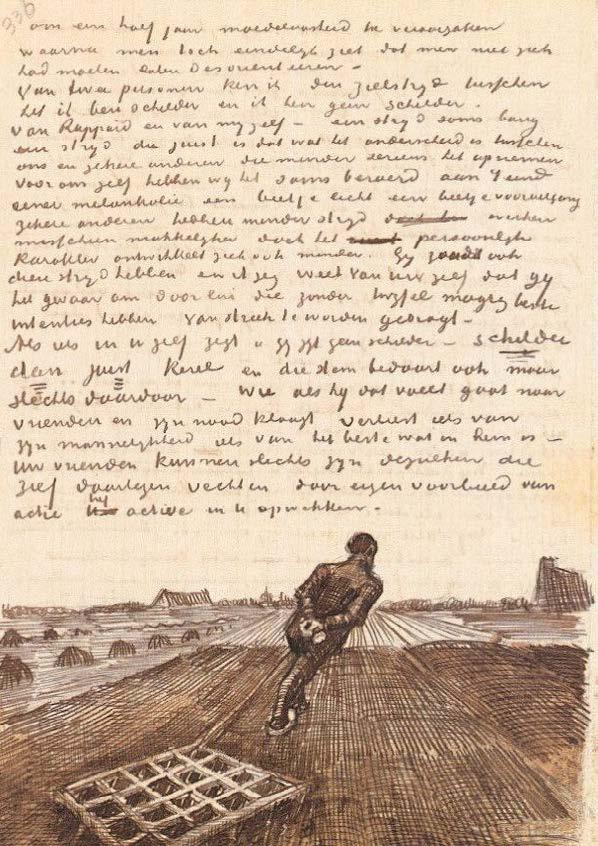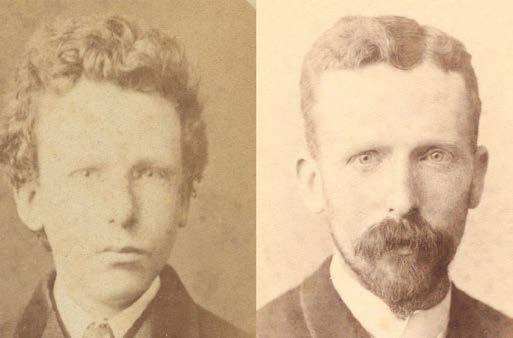
4 minute read
The letters
from Nishi Mundra
The Letters of Vincent Van Gogh
The Letters of Vincent van Gogh refers to a collection of 903 surviving letters written (820) or received (83) by Vincent van Gogh. More than 650 of these were from Vincent to his brother Theo. The collection also includes letters van Gogh wrote to his sister Wil and other relatives, as well as between artists such as Paul Gauguin, Anthon van Rappard and Émile Bernard. Vincent’s sister-in-law and wife to his brother Theo, Johanna van Gogh-Bonger, spent many years after her husband’s death in 1891 compiling the letters, which were first published in 1914.
Advertisement
The most comprehensive primary source on Van Gogh is the correspondence between him and his younger brother, Theo. Their lifelong friendship, and most of what is known of Vincent’s thoughts and theories of art, are recorded in the hundreds of letters they exchanged from 1872 until 1890. Theo van Gogh was an art dealer and provided his brother with financial and emotional support, and access to influential people on the contemporary art scene Theo (left) and Vincent (right)

Theo kept all of Vincent’s letters to him; Vincent kept few of the letters he received. After both had died, Theo’s widow Johanna arranged for the publication of some of their letters. A few appeared in 1906 and 1913; the majority were published in 1914. Vincent’s letters are eloquent and expressive and have been described as having a “diarylike intimacy”,and read in parts like autobiography. The translator Arnold Pomerans wrote that their publication
adds a “fresh dimension to the understanding of Van Gogh’s artistic achievement, an understanding granted to us by virtually no other painter”. There are more than 600 letters from Vincent to Theo and around 40 from Theo to Vincent. There are 22 to his sister Wil, 58 to the painter Anthon van Rappard, 22 to Émile Bernard as well as individual letters to Paul Signac, Paul Gauguin and the critic Albert Aurier. Some are illustrated with sketches.Many are undated, but art historians have been able to place most in chronological order. Problems in transcription and dating remain, mainly with those posted from Arles. While there Vincent wrote around 200 letters in Dutch, French and English.There is a gap in the record when he lived in Paris as the brothers lived together and had no need to correspond First published in three volumes in 1914, only 24 years after his death, the letters of Vincent Van Gogh have captivated lovers of his painting for over a century for the insights they offer into his creative bliss and anguish. They have also long been accorded the status of literature. “There is scarcely one letter by Van Gogh,” wrote W.H. Auden, “which I do not find fascinating.” That first published collection consisted only of the painter’s 651 letters to his younger brother, Theo, who died six months after Vincent. Compiled and published by Theo’s wife, Johanna, Van Gogh’s correspondence became instrumental in spreading his fame as both an artist and as a chronicler of deep emotional experiences and religious and philosophical convictions. Now available in a six-volume scholarly collection of 819 letters Vincent wrote to Theo and various family members and friends---as well as 83 letters he received---the full correspondence shows us a man who “could write very expressively and had a powerful ability to evoke a scene or landscape with
well-chosen words.” So write the Van Gogh Museum, who also host all of those letters online, with thoroughly annotated English translations, manuscript facsimiles, and more. The collection dates from 1872---with a few mundane notes written to Theo---to Van Gogh’s last letter to his brother in July of 1890. “I’d really like to write to you about many things,” Vincent begins in that final communication, “but sense the pointlessness of it.” He ends the letter with an equally ominous sentiment: “Ah well, I risk my life for my own work and my reason has half foundered in it.” In-between these very personal windows onto Van Gogh’s state of mind, we see the progression of his career. Early letters contain much discussion between him and Theo about the business of art (Vincent worked as an art dealer between 1869 and 1876). Endless money worries preoccupy the bulk of Vincent’s letters to his family. And there are later letters between Vincent and Paul Gaugin and painter Emile Bernard, almost exclusively about technique. Since he was “not in a dependent position” with artist friends as he was with family, in the few letters he exchanged with his peers, points out the Van Gogh Museum, “the sole focus was on art.” And as you can see here, Van Gogh would not only “evoke a scene or landscape” with words, but also with many dozens of illustrations. Many are sketches for paintings in progress, some quick observations and rapid portraits, and some fullycomposed scenes. Van Gogh’s sketches “basically served one purpose, which was to give the recipient an idea of something that he was working on or had finished.” (See the sketch of his room in an 1888 letter to Gauguin at the top of the post.) In early letters to Theo, the sketches—which Vincent called “scratches”-- -also served to convince his younger brother and patron of his commitment and to demonstrate his progress.













